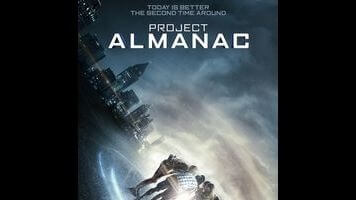What would you do if you had a time machine? For the coveted teenage demographic of Project Almanac, the answer probably isn’t radically different from how the film’s high school heroes exploit their newfound power. Discovering some mysterious blueprints tucked away in his basement, MIT-bound David (Jonny Weston) unlocks the secret to “temporal dislocation.” Soon, he and his friends are using the proverbial Second Chance Machine to give their humdrum lives a boost—passing exams they’ve already failed, getting revenge on the mean girls, winning the lottery. “It’s not Woodstock, but it’ll do,” David tells his crush, Jessie (Sofia Black D’Elia), as they leap backwards to the previous summer’s Lollapalooza. Why kill Hitler (“Time Travel 101,” as the dream girl puts it) when you can see Imagine Dragons live in concert?
Project Almanac has experienced some temporal dislocation of its own. The found-footage film was supposed to open a year ago, under the marginally more evocative title Welcome To Yesterday, but was pushed back when producers began exploring new marketing strategies with MTV Films. That’s the official story, anyway, but there are hints of tampering and tweaking, signs that the filmmakers pulled a Marty McFly on their ending. To truly improve this harmless merging of Chronicle and The Butterfly Effect, those responsible would have to rewind the clock to the pre-production stage, going back in time to the drawing board.
As a time-travel movie, Project Almanac pays fast and loose with its own fantastical rules, contradicting itself constantly. The kids stumble onto the unfinished experiment via some old video footage of the grown David wandering through the background of his own seventh birthday party, circa the distant, ancient past of 2004. (Check out those primitive flip phones!) This suggests that time travel is already built into the architecture of time, 12 Monkeys style. So how, then, can the characters also alter the course of events, reshaping the present by changing the past? At one point in the film, the quintet keeps returning to the same moment in time, attempting to save the GPA of comic-relief dork Quinn (Sam Lerner). But wouldn’t that cause a collision of doubles, the group running into multiple versions of itself on the same mission? Project Almanac has no patience for such paradoxes; it’s the type of picture that has a character say “I’ll tell you later” when another asks for an explanation—a tip-off to audiences that they too should hold their questions.
The film also breaks plenty of the cardinal laws of fake-doc filmmaking. Jump cuts and random reverse shots shatter the illusion of amateur documentation, as do a couple full-blown musical montages. Are we to believe that one of the geeks cut the digital diary of events into a conventional movie? Or has this genre gotten so loosey-goosey with its own conventions that filmmakers are no longer expected to even try to mimic the appearance of raw, unedited footage? As found-footage thrillers go, Project Almanac is perfectly watchable, but it never taps into the adolescent joy of its premise, the way Chronicle did. A better movie would have given David’s desire to go back in time and rescue his dead father a Spielbergian poignancy. Here, it’s just a rote plot point. The movie does hit on one essential truth, however: Going to Lollapalooza is always a mistake.


 Keep scrolling for more great stories from The A.V. Club.
Keep scrolling for more great stories from The A.V. Club.